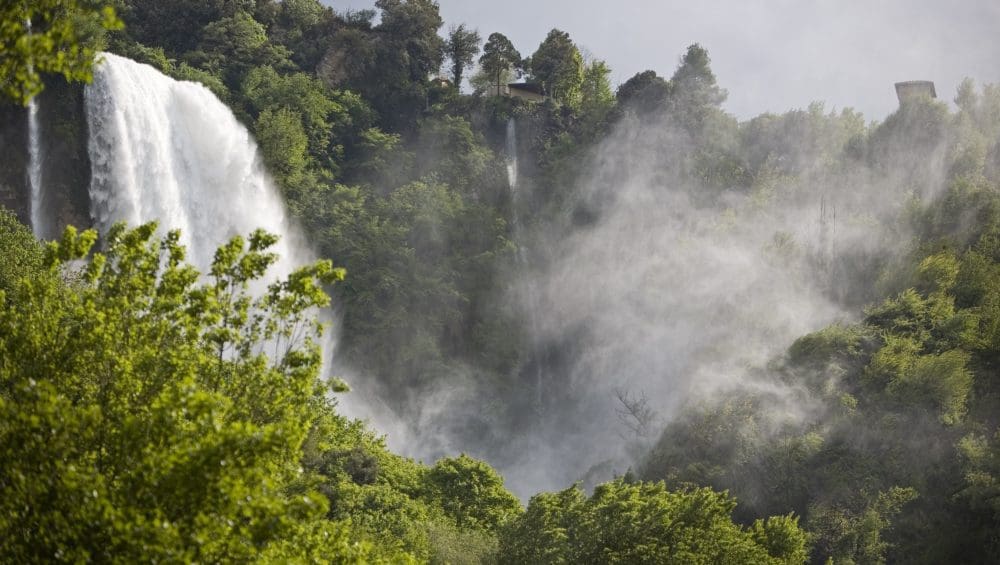La Cascata delle Marmore, formata dal Velino e dal Nera, affluenti del Tevere, è una delle attrazioni naturalistiche più visitata in Umbria, benché sia una cascata artificiale, ha origini antichissime che risalgono già all’epoca romana, nel 271 a.C: è in questa data che il console romano Manio Curio Dentato con un ingegnoso intervento idraulico, fece costruire un canale al fine di far defluire le acque che stagnavano del Velino nella Sabina (pianura reatina), pericolose per la popolazione vicina, verso il fiume Nera. L’intervento fu cosi chiamato e conosciuto nel tempo come “Cavo Curiano”.
Altri interventi fatti per contrastare gli allagamenti nei periodi di piena dei fiumi risalgono al 1422, a cura dell’ingegnere Aristotile Fioravanti e affidati da Braccio Fortebraccio da Montone. In quest’occasione fu realizzato un nuovo canale chiamato “reatino”. Altri interventi risalgono nel 1547 da Antonio Da Sangallo, su commissione di Papa Paolo III con la costruzione di un terzo canale. Nel 1601 l’architetto Giovanni Fontana realizzò il canale “clementino” in onore di Papa Clemente III. Infine nel 1787 l’architetto Andrea Vici fece l’ultimo intervento che consegnò alla Cascata delle Marmore l’aspetto attuale.
Ad oggi la Cascata delle Marmore risulta la più alta cascata artificiale d’Europa.
CURIOSITÀ
- Il nome deriva dalla ricchezza di carbonato di calcio sulle rocce che ricorda il marmo bianco.
- Oggi la Cascata non è solo un’importante attrazione turistica e naturalistica per la ricchezza di flora e fauna, dalle alghe, muschi, felci, insetti, pesci, rettili, uccelli e piccoli mammiferi, ma è anche utilizzata per la produzione idroelettrica.
- La Cascata non è sempre aperta a pieno regime (Attenti agli orari di apertura così da non perdere questo affascinante momento!!), e questo permette di ammirare la bellezza e la ricchezza della vegetazione che si mostra quando il flusso d’acqua della cascata è chiusa. La sua apertura viene annunciata attraverso un segnale acustico. Meravigliosa la vista dell’acqua che si getta con forza e crea, nelle giornate di sole, un meraviglioso arcobaleno. È possibile accedere alla Cascate sia dal Belvedere superiore sia dal Belvedere inferiore.
- La notte le acque della cascata, quando aperte, sono illuminate da un impianto di illuminazioni a led.
- La bellezza del Parco della Cascate delle Marmore è data anche dal poter ammirare lungo il percorso le grotte che l’acqua ha scavato nei secoli con stalattiti e stalagmiti nel travertino: alcune si possono visitare e la più famosa è la GROTTA DEGLI INNAMORATI
UNA ROMANTICA LEGGENDA
Lo Gnefro, una creatura fatata e leggendaria della cultura popolare umbra, narra la storia della ninfa di nome Nera invaghita del pastore Velino. La dea Giunone, che non accettava un amore tra una ninfa e un essere umano, trasformò la ninfa Nera in un fiume. Velino, credendo che la Ninfa Nera stesse affogando in quelle acque sino ad allora sconosciute, vi si gettò. Giove però, intenerito dal puro amore, trasformò anche il pastore Velino in fiume. Da allora il fiume Nera e fiume Velino poterono stare insieme per l’eternità.
LO SAPEVI CHE
- Il soprano Gina Palmucci, profondamente innamorata del suo territorio, essendo di origini ternane, scelse come suo nome d’arte Nera Marmora;
- La Cascata delle Marmore è stata dipinta da diversi pittori e raccontate da importanti letterali come Lord Byron;
- È presente in molti film come Intervista di Federico Fellini nel 1987, la Sindrome di Stendhal di Dario Argento nel 1996, e ancora in fiction come Don Matteo;
- Nel 2011 è la location per il concerto con l’orchestra
“I Filarmonici di Roma” e nel 2012 il concerto per il “Tributo a Sergio Endrigo” di Simone Cristicchi; - Nel 2017 è protagonista della campagna pubblicitaria per la promozione del Turismo in Umbria insieme alla ex tuffatrice italiana Tania Cagnotto;
- A gennaio 2023 è stata la location per la prova in esterna della trasmissione MasterChef.



